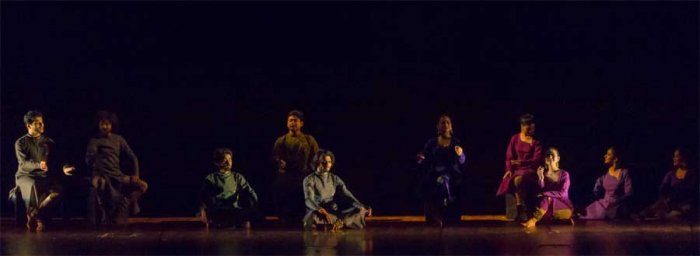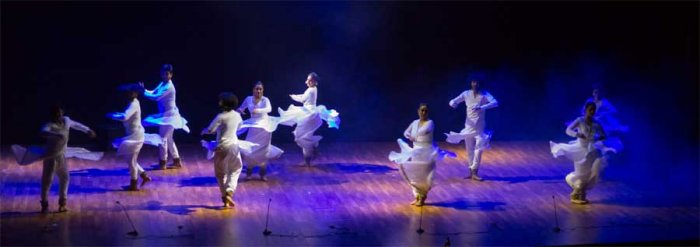
|   |

|   |
Vivarta - a visual treat - Sapna Nanjunde Photos courtesy: Kadamb April 14, 2017 Vivarta, a Kathak group dance production from the Kadamb Dance Academy, choreographed by the legendary Kathak Guru Kumudini Lakhia, was staged at Pt. Din Dayal Upadhyay Auditorium on 22nd of March 2017 in Ahmedabad. It was a great visual treat and an excellent learning experience for us, the students of Indian classical dance. The production was based on the poem ‘Ni-ra-tata-dhang,’ a composition by Maharaj Bindadin, the Adiguru of Kathak. This poetic composition is a ‘Lakshan Geet’ - a song enumerating the salient features of this dance form. The famous composition was beautifully interpreted in Kumudini Lakhia’s choreography, one that highlighted many facets of our rich Indian culture. Vivarta means transformation, a total change from what it was like earlier. Native to northern India, Kathak originated within the Hindu temples as a means of portraying epic tales. The nomadic Kathakar further developed the dance to include elements of mime. It later transitioned from its secluded, devotional origins, and became an established part of court culture, performed under the special patronage of India’s Mughal emperors. During this period, the emotional and graceful storytelling Hindu roots combined with the more technical postures, subtle sensual gestures and rhythmic movements influenced by the dancers and musicians from Persia. Kathak evolved during the Bhakti movement, particularly by incorporating childhood and amorous stories of Krishna and Radha and Gopis. Over the centuries, Kathak has become refined and enriched itself with various hues. However, it has retained its form, beauty and substance through the ages.  The individual or group items presented in Vivarta range from expressive or narrative sections illustrating poetry or telling stories from Hindu mythology to complex rhythmic pieces. The synthesis of Hindu and Muslim cultures was shown in the diverse styles and technique of dance including costumes, as it unfolded in various stanzas of Bindadin’s composition. The one hour plus performance had seven stanzas - each with its own mood and theme. The first stanza laid out the locale – the fragrant gently flowing breeze, the beautiful river Yamuna, the soothing sound of the flute from afar where Gopis performed the raas leela with Krishna. In the second verse, the poet evokes the Gods - Brahma, Vishnu, Mahesh and Narad to bless the eternal romantic pair of Radha and Krishna. In another verse, the poet describes the divine beauty of Radha, the daughter of Brijbhan. One group dance had girls dancing with cymbals chanting praise of Lord Krishna, a style reminiscent of the Bhakti cult. In a solo dance sequence, Sanjukata Sinha (Kumudini Lakhia’s student), portraying Radha, conveyed mystical love for Krishna using subtle bhavas. The flowing movements, intricate footwork alternating between slow and fast paces, and heady whirls ending in decorative poses were executed with graceful ease. The music matched the poetic elegance of the composition, further enhancing the devotional fervour of the piece. The tarana (Persian word meaning a song) added before the seventh stanza had actual bols of the Kathak vocabulary, with dancers reciting the syllables, which was rendered at different paces. Later, in the same dance piece, the movement patterns to these bols were executed brilliantly by both male and female dancers together. This was set to an imaginative light background which showed a jali – mesh window - a hallmark of Islamic architecture. The dancers in one performance piece donned Hindu costume - long skirt or the ghagra accompanied by a blouse and a veil or dupatta. And in other piece, they wore a churidar kameez combination – a Muslim influence. Male Kathak dancers wore kurta and pyjama. The precise footwork, as well as the graceful yet detailed carriage of the upper body, hand placements, the chakkars ending in graceful poses, and facial expressions demonstrated Kathak’s diverse cultural influences.  The music was composed by renowned Hindustani classical music vocalist Pandit Madhup Mudgal. The spectacular performance by the dancers took the viewers close to the distinctive features of Kathak dance tradition with elements of both Hindu and Muslim culture amalgamated in this form. Accompanied by their colourful costumes and adornments, the dancers themselves were moving works of art. Each of the pieces and especially the closing one held the audience absolutely spellbound and mesmerized. Vivarta, a product of a series of fusions, was projected as an intact and purely Indian classical tradition rooted deeply in the past and enhanced the appreciation of Kathak dance. Sapna Nanjunde is a student at Rasadhwani, Ahmedabad. This report was written by her for a class assignment. |